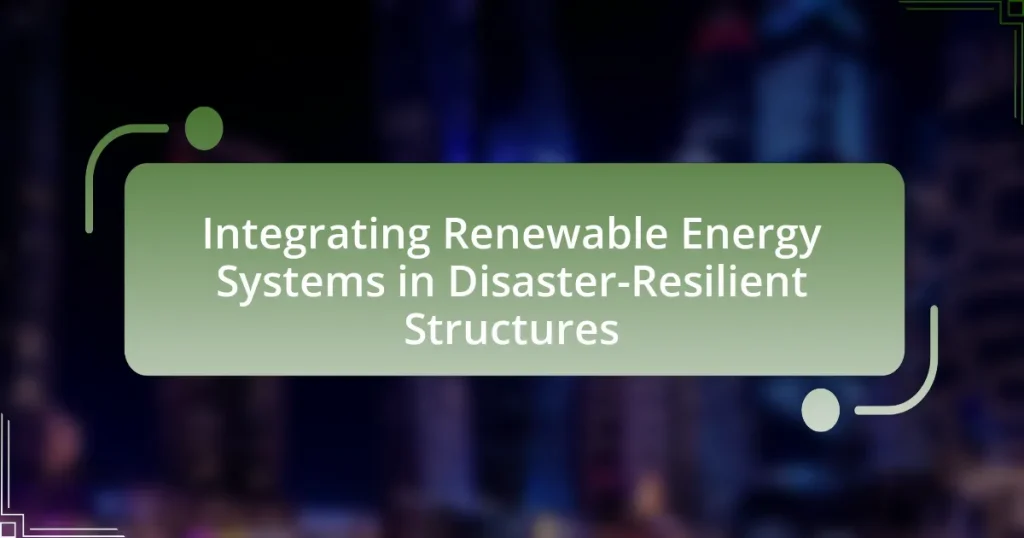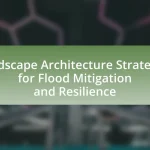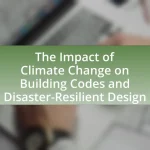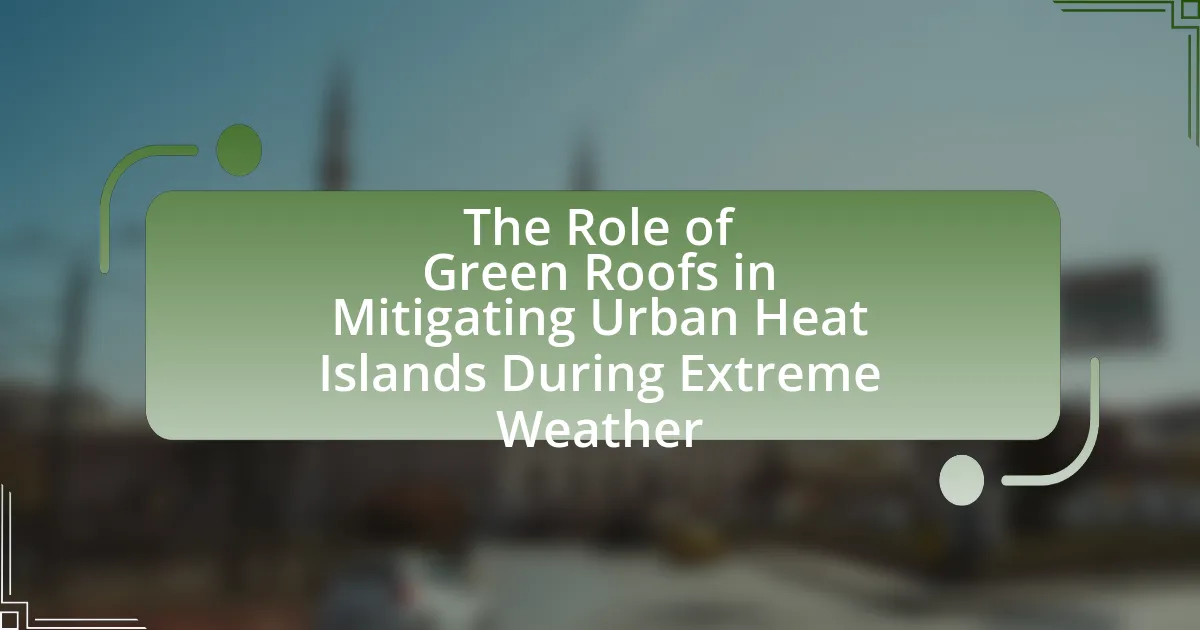Integrating Renewable Energy Systems in Disaster-Resilient Structures focuses on the combination of sustainable energy technologies, such as solar and wind power, with buildings designed to withstand natural disasters. The article outlines how these systems enhance energy independence and reliability during emergencies, providing critical power when traditional grids fail. It discusses the effectiveness of various renewable sources in disaster scenarios, the architectural strategies for integration, and the challenges faced, including financial and regulatory barriers. Additionally, it highlights best practices for successful implementation and the importance of community engagement and policy changes in promoting renewable energy adoption for improved disaster resilience.
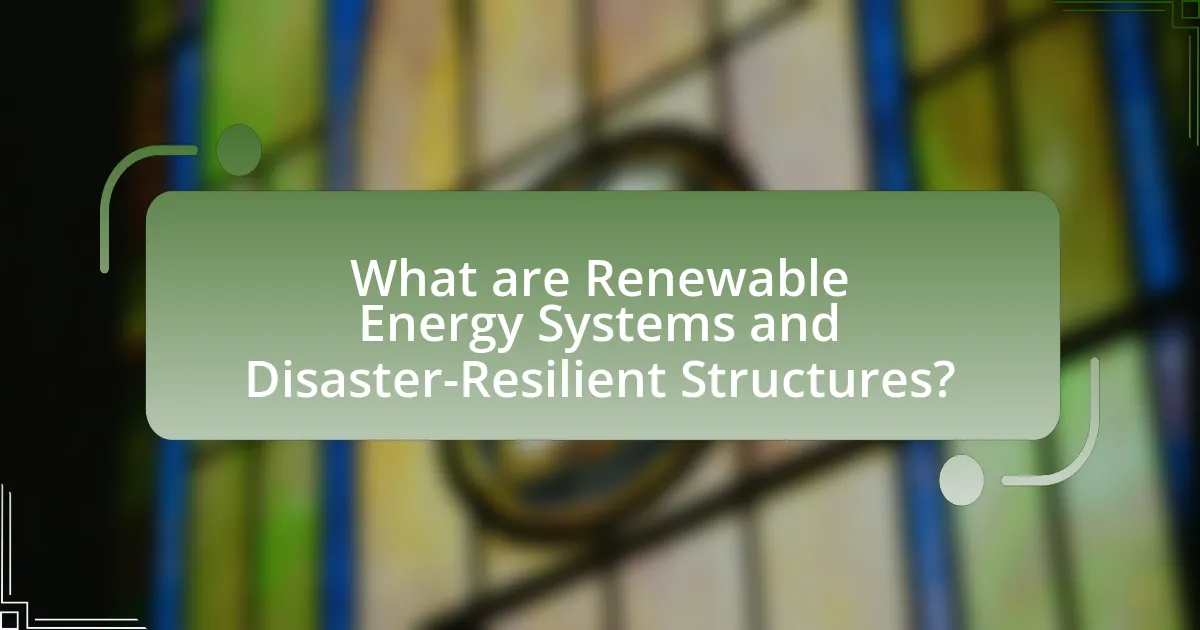
What are Renewable Energy Systems and Disaster-Resilient Structures?
Renewable Energy Systems are technologies that harness energy from natural resources, such as solar, wind, hydro, and geothermal sources, to generate electricity or heat. These systems are designed to be sustainable and reduce reliance on fossil fuels, contributing to lower greenhouse gas emissions. Disaster-Resilient Structures are buildings engineered to withstand natural disasters, such as earthquakes, floods, and hurricanes, ensuring safety and functionality during and after such events. The integration of Renewable Energy Systems into Disaster-Resilient Structures enhances energy independence and sustainability, allowing these buildings to maintain power during emergencies. For example, solar panels can provide electricity even when the grid is down, demonstrating the effectiveness of this integration in real-world scenarios.
How do Renewable Energy Systems contribute to disaster resilience?
Renewable Energy Systems enhance disaster resilience by providing reliable power during and after catastrophic events. These systems, such as solar panels and wind turbines, can operate independently of traditional grid infrastructure, which often fails during disasters. For instance, during Hurricane Sandy in 2012, communities with solar energy systems were able to maintain power when the grid was down, demonstrating their effectiveness in crisis situations. Additionally, renewable energy sources reduce dependency on fossil fuels, which can be disrupted during disasters, thereby ensuring a more stable energy supply. This capability not only supports emergency response efforts but also aids in recovery by powering essential services and infrastructure, ultimately contributing to a community’s ability to withstand and recover from disasters.
What types of renewable energy sources are most effective in disaster scenarios?
Solar energy and wind energy are the most effective renewable energy sources in disaster scenarios. Solar panels can be deployed quickly and provide immediate power, which is crucial for emergency response efforts. For instance, during Hurricane Sandy in 2012, solar energy systems were used to restore power in affected areas, demonstrating their reliability in crisis situations. Wind energy can also be harnessed, particularly in regions where wind resources are abundant, providing a sustainable power source when traditional grids fail. The effectiveness of these renewable sources is further supported by their ability to operate independently of centralized infrastructure, making them ideal for disaster resilience.
How do disaster-resilient structures integrate renewable energy systems?
Disaster-resilient structures integrate renewable energy systems by incorporating technologies such as solar panels, wind turbines, and energy storage solutions into their design. These systems provide a reliable energy source during and after disasters, ensuring that critical services remain operational. For instance, solar panels can be installed on rooftops to harness sunlight, while wind turbines can be strategically placed to capture wind energy, both of which contribute to energy independence and sustainability. Additionally, energy storage systems, like batteries, can store excess energy generated during normal conditions for use during emergencies. This integration not only enhances the resilience of the structures but also reduces reliance on traditional energy sources, which may be disrupted during disasters.
Why is integrating renewable energy systems important for disaster resilience?
Integrating renewable energy systems is crucial for disaster resilience because they provide a reliable and sustainable power source during and after disasters. Renewable energy systems, such as solar panels and wind turbines, can operate independently of traditional power grids, which are often damaged or fail during catastrophic events. For instance, after Hurricane Maria in 2017, areas that utilized solar microgrids were able to restore power more quickly than those reliant on conventional energy sources. This independence enhances community resilience, ensuring that essential services like hospitals and emergency shelters remain operational, thereby reducing vulnerability and improving recovery times.
What are the potential impacts of climate change on energy systems and structures?
Climate change significantly impacts energy systems and structures by increasing the frequency and intensity of extreme weather events, which can disrupt energy supply and infrastructure. For instance, rising temperatures can lead to higher electricity demand for cooling, while severe storms can damage power lines and facilities, resulting in outages. According to the U.S. Department of Energy, climate-related disruptions could cost the energy sector billions annually, highlighting the vulnerability of energy infrastructure to climate change. Additionally, changing precipitation patterns can affect hydropower generation and water availability for cooling in thermal power plants, further stressing energy systems.
How can renewable energy systems enhance the sustainability of disaster-resilient structures?
Renewable energy systems enhance the sustainability of disaster-resilient structures by providing reliable, clean energy sources that reduce dependency on fossil fuels and improve energy security during emergencies. These systems, such as solar panels and wind turbines, can be integrated into building designs to ensure that structures remain operational even when traditional power grids fail. For instance, a study by the National Renewable Energy Laboratory found that buildings equipped with solar energy systems can maintain power during natural disasters, thus supporting critical functions like emergency response and sheltering. Additionally, renewable energy systems contribute to lower greenhouse gas emissions, aligning with sustainability goals and promoting environmental resilience in the face of climate change.
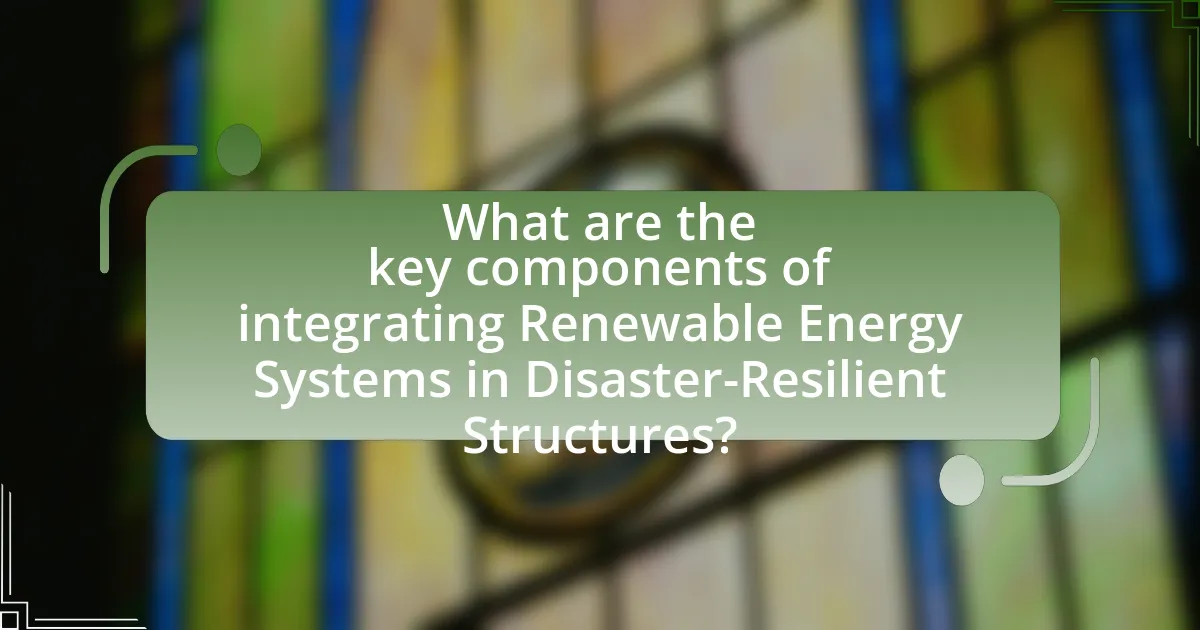
What are the key components of integrating Renewable Energy Systems in Disaster-Resilient Structures?
The key components of integrating Renewable Energy Systems in Disaster-Resilient Structures include energy generation, energy storage, grid connectivity, and system adaptability. Energy generation involves the use of solar panels, wind turbines, or biomass systems to produce electricity, which is crucial for maintaining power during and after disasters. Energy storage systems, such as batteries, ensure that generated energy can be stored for use when conventional power sources are unavailable. Grid connectivity allows for the integration of renewable systems with existing infrastructure, enabling a seamless transition during emergencies. Finally, system adaptability ensures that renewable energy solutions can be modified or scaled according to specific disaster scenarios, enhancing resilience. These components collectively contribute to the sustainability and reliability of structures in disaster-prone areas.
What technologies are involved in renewable energy integration?
Renewable energy integration involves several key technologies, including solar photovoltaic systems, wind turbines, energy storage systems, smart grids, and demand response technologies. Solar photovoltaic systems convert sunlight into electricity, while wind turbines harness wind energy for power generation. Energy storage systems, such as batteries, store excess energy for use during low production periods, enhancing reliability. Smart grids facilitate real-time communication between energy producers and consumers, optimizing energy distribution and consumption. Demand response technologies adjust consumer energy usage based on supply conditions, improving efficiency and stability in the energy system. These technologies collectively enable the effective incorporation of renewable energy sources into existing energy infrastructures, promoting sustainability and resilience.
How do solar panels function in disaster-resilient designs?
Solar panels function in disaster-resilient designs by providing a reliable and independent source of energy during and after catastrophic events. They can operate off-grid, ensuring that essential services such as lighting, communication, and medical facilities remain functional when traditional power sources fail. For instance, during Hurricane Sandy in 2012, solar-powered systems enabled critical infrastructure to maintain operations despite widespread power outages. Additionally, solar panels are often designed to withstand extreme weather conditions, including high winds and heavy rainfall, which enhances their durability and effectiveness in disaster scenarios. This resilience is supported by advancements in technology, such as the use of impact-resistant materials and secure mounting systems, which further solidify their role in sustainable disaster recovery efforts.
What role do wind turbines play in enhancing structural resilience?
Wind turbines enhance structural resilience by providing a reliable source of renewable energy that can support critical infrastructure during disasters. Their integration into disaster-resilient structures allows for continuous power supply, which is essential for emergency services and recovery efforts. For instance, during Hurricane Sandy in 2012, wind turbines in certain areas continued to operate and supply power even when conventional energy sources failed, demonstrating their capability to maintain energy availability in adverse conditions. This resilience is further supported by advancements in turbine design, which include features that allow them to withstand extreme weather events, thereby reducing the risk of structural failure and ensuring operational continuity.
What are the design considerations for integrating these systems?
Design considerations for integrating renewable energy systems in disaster-resilient structures include system compatibility, energy storage solutions, and structural integrity. System compatibility ensures that renewable energy technologies, such as solar panels or wind turbines, can effectively work with existing infrastructure and energy systems. Energy storage solutions, like batteries, are crucial for maintaining power supply during outages, particularly in disaster scenarios. Structural integrity must be assessed to ensure that the building can withstand extreme weather conditions while supporting the additional weight and requirements of renewable energy installations. These considerations are essential for creating resilient structures that can maintain functionality during and after disasters.
How can building materials affect the integration of renewable energy systems?
Building materials significantly influence the integration of renewable energy systems by determining the structural capacity, thermal performance, and energy efficiency of a building. For instance, materials with high thermal mass, such as concrete or brick, can enhance energy storage and reduce heating and cooling demands, thereby optimizing the performance of solar panels and other renewable technologies. Additionally, the choice of materials affects the installation of renewable energy systems; lightweight materials may facilitate easier mounting of solar panels, while durable materials can withstand the stresses associated with wind and seismic activity, which is crucial for disaster-resilient structures. Research indicates that buildings designed with energy-efficient materials can achieve up to 30% greater energy savings when integrating renewable energy systems, demonstrating the critical role of material selection in maximizing renewable energy potential.
What architectural strategies support the integration of renewable energy systems?
Architectural strategies that support the integration of renewable energy systems include passive solar design, building orientation, and the use of energy-efficient materials. Passive solar design maximizes natural light and heat, reducing reliance on artificial energy sources. Building orientation is crucial; structures should be positioned to capture optimal sunlight for solar panels and minimize energy loss. Additionally, energy-efficient materials, such as high-performance insulation and windows, enhance the overall energy performance of buildings, facilitating the effective use of renewable energy systems. These strategies collectively contribute to a sustainable and resilient architectural framework, essential for disaster-resilient structures.
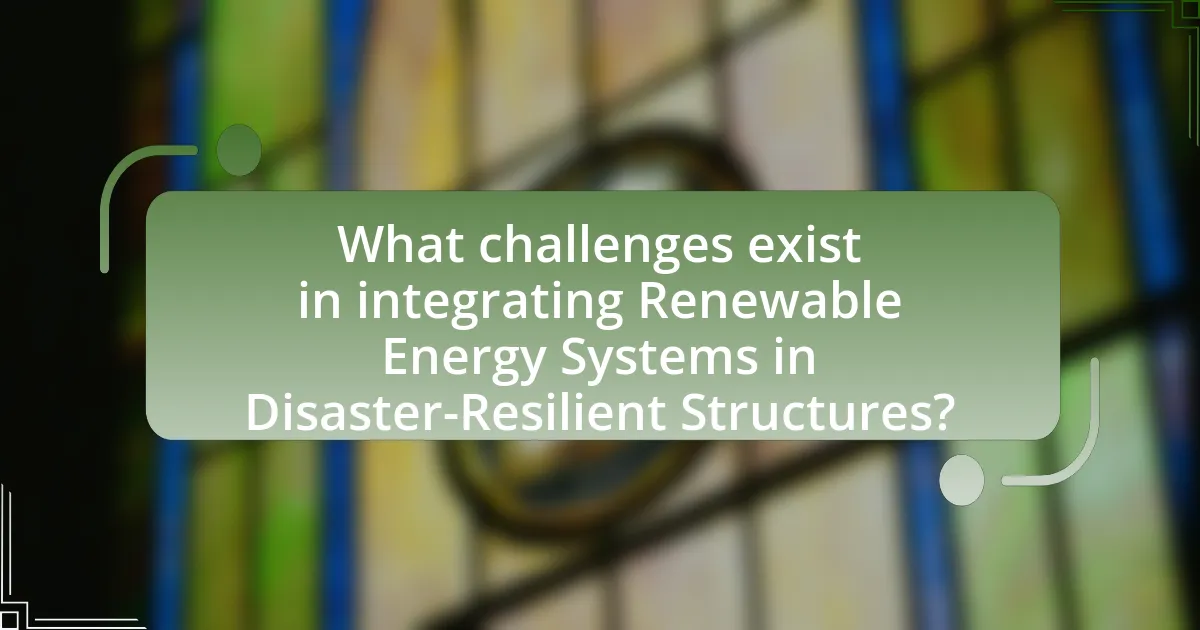
What challenges exist in integrating Renewable Energy Systems in Disaster-Resilient Structures?
Integrating Renewable Energy Systems in Disaster-Resilient Structures faces several challenges, including technical, financial, and regulatory barriers. Technical challenges arise from the need to ensure that renewable energy systems, such as solar panels and wind turbines, can withstand extreme weather conditions and seismic events, which are critical for disaster resilience. Financial challenges include the high initial costs of installing these systems, which can deter investment, especially in regions with limited funding for disaster preparedness. Regulatory barriers often involve complex permitting processes and building codes that may not accommodate innovative renewable technologies, hindering their integration into disaster-resilient designs. These challenges must be addressed to effectively combine renewable energy systems with disaster-resilient infrastructure.
What are the common barriers to implementation?
Common barriers to implementation of renewable energy systems in disaster-resilient structures include high initial costs, lack of technical expertise, regulatory challenges, and insufficient infrastructure. High initial costs deter investment, as many stakeholders are hesitant to allocate significant funds without guaranteed returns. Lack of technical expertise limits the ability to design and install these systems effectively, leading to suboptimal performance. Regulatory challenges arise from complex permitting processes and inconsistent policies that can delay or prevent implementation. Insufficient infrastructure, particularly in disaster-prone areas, hampers the integration of renewable energy systems, as existing facilities may not support new technologies. These barriers collectively hinder the widespread adoption of renewable energy solutions in disaster-resilient construction.
How do regulatory frameworks impact the integration process?
Regulatory frameworks significantly influence the integration process of renewable energy systems in disaster-resilient structures by establishing guidelines that dictate compliance, safety, and operational standards. These frameworks ensure that renewable energy technologies, such as solar panels and wind turbines, meet specific performance criteria and safety regulations, which can facilitate or hinder their deployment. For instance, the International Renewable Energy Agency (IRENA) emphasizes that clear regulatory policies can enhance investment in renewable energy by providing certainty and reducing risks for developers. Additionally, local building codes and zoning laws can either promote or restrict the installation of renewable energy systems, impacting their integration into disaster-resilient designs.
What financial challenges do developers face when integrating these systems?
Developers face significant financial challenges when integrating renewable energy systems into disaster-resilient structures, primarily due to high upfront costs and ongoing maintenance expenses. The initial investment for renewable technologies, such as solar panels or wind turbines, can be substantial, often requiring financing that may not be readily available. Additionally, the integration process can involve complex engineering and regulatory compliance costs, which further inflate the budget. According to a report by the International Renewable Energy Agency, the average capital cost for solar photovoltaic systems can range from $1,000 to $3,000 per installed kilowatt, depending on the location and technology used. This financial burden can deter developers from pursuing such projects, especially in regions with limited funding options or economic constraints.
How can these challenges be overcome?
To overcome the challenges of integrating renewable energy systems in disaster-resilient structures, a multi-faceted approach is essential. This includes employing advanced engineering techniques to enhance structural integrity, utilizing modular and scalable renewable energy technologies, and implementing comprehensive risk assessment frameworks. For instance, the use of resilient design principles, such as those outlined in the ASCE 7 standards, can significantly improve a structure’s ability to withstand extreme weather events. Additionally, integrating energy storage solutions, like lithium-ion batteries, can ensure a reliable power supply during and after disasters, as evidenced by their effectiveness in recent hurricane recovery efforts.
What best practices can be adopted for successful integration?
Successful integration of renewable energy systems in disaster-resilient structures can be achieved by adopting best practices such as conducting thorough site assessments, ensuring compatibility with existing infrastructure, and implementing robust safety measures. Site assessments identify optimal locations for renewable installations, considering factors like sunlight exposure for solar panels or wind patterns for turbines. Compatibility with existing infrastructure ensures that new systems can be seamlessly integrated without significant modifications, which is crucial for maintaining structural integrity during disasters. Additionally, robust safety measures, including redundancy systems and compliance with local building codes, enhance resilience against extreme weather events. These practices are supported by case studies demonstrating that structures incorporating these strategies have shown improved performance during disasters, thereby validating their effectiveness.
How can community engagement enhance the integration of renewable energy systems?
Community engagement enhances the integration of renewable energy systems by fostering local support, increasing awareness, and facilitating collaboration among stakeholders. Engaged communities are more likely to advocate for renewable projects, leading to smoother implementation and reduced opposition. For instance, studies show that projects with strong community involvement experience a 30% increase in acceptance rates compared to those without. Additionally, community input can guide the design and location of renewable systems, ensuring they meet local needs and preferences, which further promotes successful integration.
What are the future trends in integrating Renewable Energy Systems in Disaster-Resilient Structures?
Future trends in integrating Renewable Energy Systems in Disaster-Resilient Structures include the increased adoption of solar photovoltaic systems, energy storage solutions, and smart grid technologies. These advancements are driven by the need for sustainable energy sources that can withstand extreme weather events and provide reliable power during disasters. For instance, the integration of solar panels with battery storage allows buildings to maintain energy supply even when the grid is down, enhancing resilience. Additionally, the use of microgrid systems enables localized energy generation and distribution, which is crucial in disaster scenarios. Research indicates that buildings designed with these systems can reduce energy costs by up to 50% while improving their ability to function during emergencies.
How is technology evolving to support better integration?
Technology is evolving to support better integration of renewable energy systems in disaster-resilient structures through advancements in smart grid technology, energy management systems, and modular design. Smart grids enable real-time monitoring and management of energy resources, facilitating seamless integration of various renewable sources like solar and wind. Energy management systems optimize energy usage and storage, ensuring that renewable energy is efficiently utilized during disasters. Modular design allows for flexible and scalable integration of renewable systems, making it easier to adapt to different structural needs and environmental conditions. These advancements collectively enhance the resilience and efficiency of energy systems in disaster-prone areas.
What role do policy changes play in the future of renewable energy integration?
Policy changes are crucial for the future of renewable energy integration as they establish the regulatory framework that supports investment, development, and deployment of renewable technologies. Effective policies can incentivize the adoption of renewable energy through tax credits, subsidies, and renewable portfolio standards, which have been shown to increase renewable energy capacity significantly. For instance, the U.S. Energy Information Administration reported that federal tax incentives contributed to a 60% increase in solar energy capacity from 2016 to 2020. Additionally, policies that promote grid modernization and interconnection standards facilitate the integration of renewable sources into existing energy systems, enhancing reliability and resilience, particularly in disaster-prone areas. Thus, policy changes directly influence the pace and scale of renewable energy integration, shaping a sustainable energy future.
What practical steps can be taken to implement these systems effectively?
To implement renewable energy systems effectively in disaster-resilient structures, the first practical step is to conduct a comprehensive site assessment to evaluate local renewable resources, such as solar, wind, or geothermal energy. This assessment informs the selection of appropriate technologies tailored to the specific environmental conditions and energy needs of the structure.
Next, integrating these systems requires collaboration with engineers and architects to ensure that the design accommodates the renewable technologies without compromising structural integrity. For instance, solar panels should be installed on roofs designed to withstand extreme weather conditions, as evidenced by the success of solar installations in hurricane-prone areas, which have demonstrated resilience when properly engineered.
Additionally, securing funding and incentives is crucial; many governments offer grants or tax credits for renewable energy projects, which can significantly reduce upfront costs. For example, the U.S. federal solar tax credit allows homeowners to deduct a percentage of the installation costs from their federal taxes, promoting wider adoption of solar energy systems.
Finally, establishing a maintenance plan ensures the longevity and efficiency of the renewable systems. Regular inspections and timely repairs can prevent system failures during emergencies, as highlighted by studies showing that well-maintained renewable systems perform better in disaster scenarios.
How can stakeholders collaborate to ensure successful integration?
Stakeholders can collaborate to ensure successful integration of renewable energy systems in disaster-resilient structures by establishing clear communication channels and shared goals. Effective collaboration involves regular meetings to align objectives, sharing resources and expertise, and engaging in joint planning and decision-making processes. For instance, studies show that collaborative frameworks, such as public-private partnerships, enhance project outcomes by pooling knowledge and financial resources, leading to more resilient infrastructure. Additionally, involving local communities in the planning phase fosters trust and ensures that the systems meet specific needs, thereby increasing the likelihood of successful integration.
What resources are available for communities looking to integrate renewable energy systems?
Communities looking to integrate renewable energy systems can access various resources, including government grants, technical assistance programs, and educational materials. For instance, the U.S. Department of Energy offers funding opportunities through initiatives like the Solar Energy Technologies Office, which supports solar energy projects. Additionally, organizations such as the National Renewable Energy Laboratory provide technical assistance and research to help communities implement renewable energy solutions effectively. Furthermore, local governments often have programs that facilitate the adoption of renewable technologies, including incentives for solar panel installations and energy efficiency upgrades. These resources collectively empower communities to transition to sustainable energy systems while enhancing resilience against disasters.
